Termination of business relationship letter template
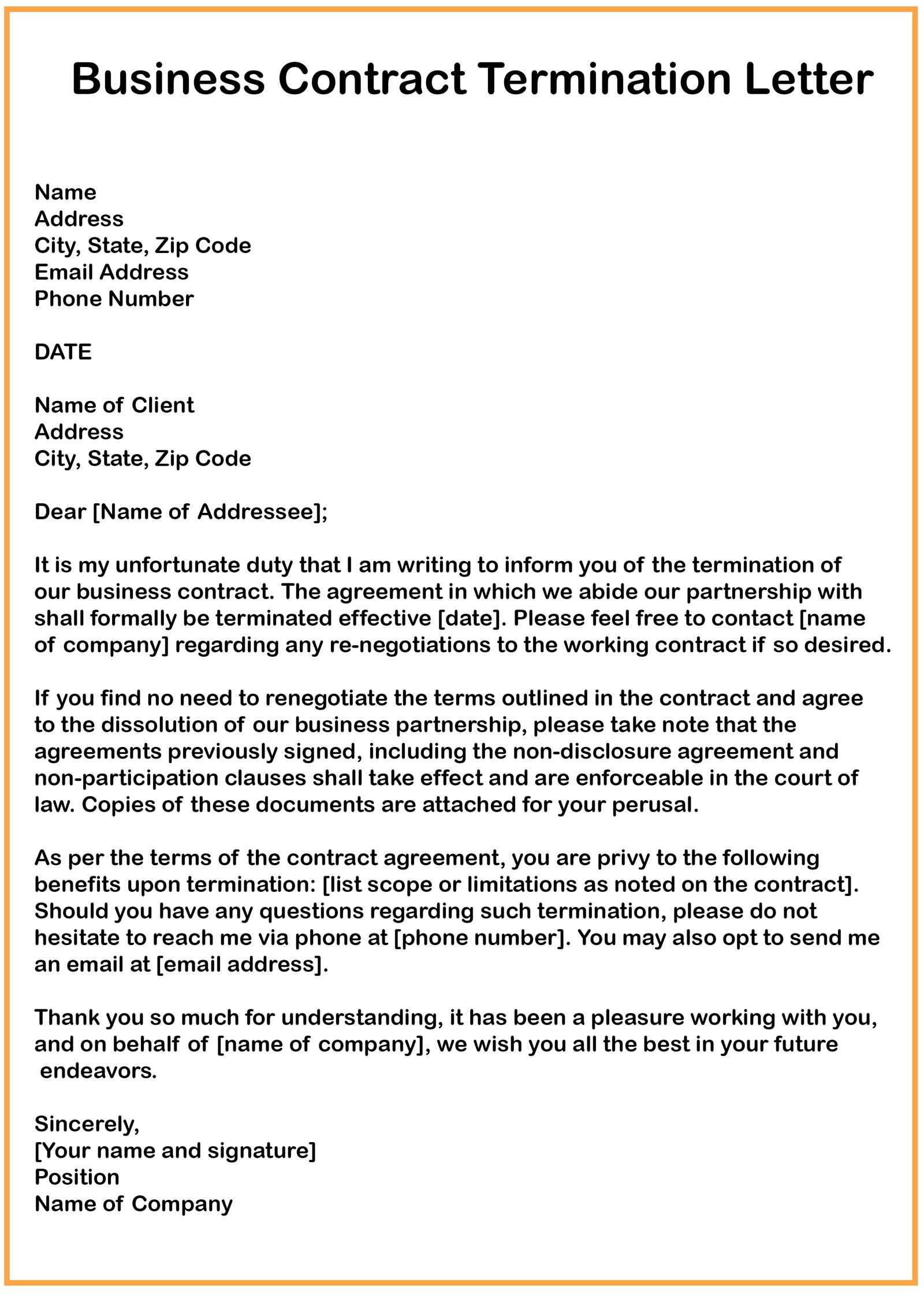
Begin the letter by addressing the recipient clearly and professionally. Use a direct, respectful tone to convey the intention of ending the business relationship, specifying the reasons briefly but firmly. Avoid unnecessary elaboration, and focus on clarity and precision.
For example, mention any contractual obligations, payment terms, or conditions that have led to this decision. It’s important to ensure that the language used remains neutral and does not cast blame, keeping the door open for future communication or collaboration if needed.
In the closing paragraph, offer to assist with a smooth transition, if applicable, and express gratitude for the past business partnership. This ensures the letter ends on a polite and professional note, maintaining a positive rapport despite the termination.
Here is the revised version with minimal repetition:
Ensure clarity by directly stating the termination of the relationship. Keep the tone polite yet firm, without ambiguity. Begin with a clear subject line that immediately communicates the purpose of the letter.
1. Open with Directness
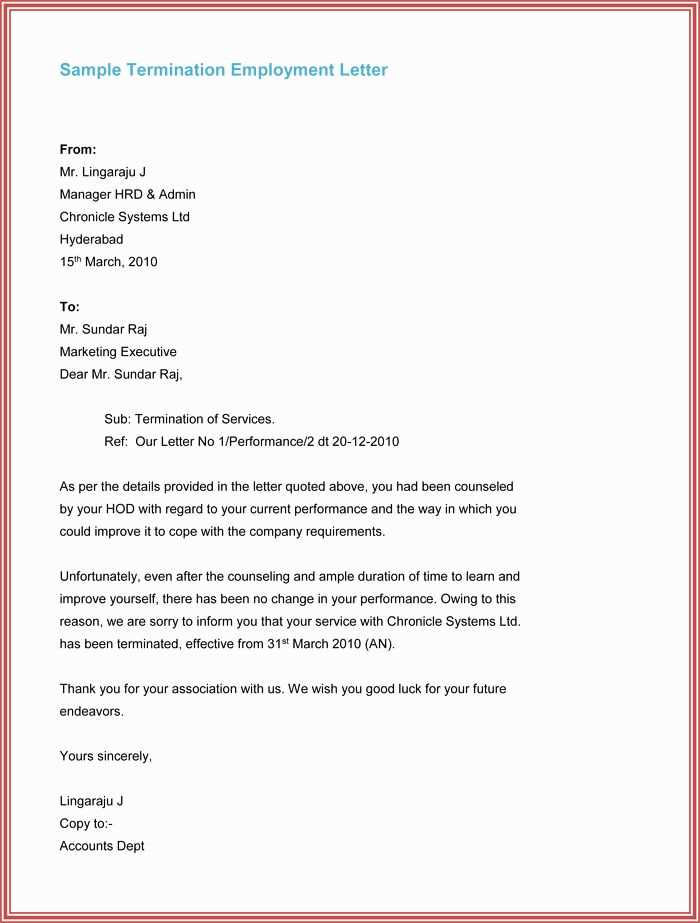
Avoid unnecessary preambles. State the reason for ending the business relationship early in the letter. For example: “We regret to inform you that we are terminating our business relationship effective [date].”
2. Provide Reasoning Briefly
If appropriate, offer a concise reason for the decision, but avoid excessive detail. Be neutral and factual, such as: “This decision follows changes in our company’s direction and operations.”
Conclude the letter with appreciation for the previous collaboration and a willingness to resolve any final matters. Always offer a clear next step or point of contact for any follow-up.
- Termination of Business Relationship Letter Template
Use a clear and straightforward tone when drafting a termination letter. This ensures the message is conveyed professionally and avoids ambiguity. Keep the content factual and to the point, addressing all necessary points without over-explaining.
Key Components of the Letter
Include the following elements in the termination letter:
| Component | Details |
|---|---|
| Date | State the exact date the letter is being written. |
| Recipient Information | Include the full name, company name, and address of the recipient. |
| Subject Line | Clearly state the purpose of the letter, such as “Termination of Business Relationship.” |
| Introduction | Begin with a direct statement of the termination, mentioning the business relationship being ended. |
| Reason for Termination | Briefly explain the reason for ending the relationship (if applicable). |
| Details on Outstanding Matters | Address any remaining obligations or procedures that need to be followed before the termination is final. |
| Conclusion | End with a courteous note, expressing appreciation for the business relationship, even if it’s ending. |
Sample Template
Here’s a template you can modify to suit your specific needs:
Dear [Recipient’s Name],
We are writing to inform you that [Your Company Name] will be terminating our business relationship effective [Date]. This decision has been made due to [Reason for termination]. We appreciate the efforts made during our partnership, and we wish you continued success in the future.
Please ensure that all outstanding matters are resolved by [Date]. If you have any questions or need further clarification, do not hesitate to contact us.
Thank you for your time and cooperation.
Sincerely,
[Your Name]
[Your Position]
[Your Company Name]
This section offers a concise, practical approach to drafting a business termination letter, detailing what to include and providing a clear template to work from.
Use a neutral, clear, and professional tone when drafting a termination letter. Avoid emotional language and keep the message focused on facts. Ensure that your choice of words reflects the need for a formal business decision rather than personal conflict.
Be concise and direct about the reasons for termination. Providing clarity in a straightforward manner helps prevent confusion and allows the recipient to understand the situation without ambiguity. It’s also important to avoid using overly harsh or overly apologetic language, as it can create unnecessary tension or misunderstandings.
While maintaining professionalism, it’s helpful to include a note of appreciation for the time and effort the recipient contributed to the business relationship. A respectful acknowledgment can soften the impact of the termination and leave the door open for potential future collaboration.
Clearly state the reason for ending the business relationship. Be direct and concise, avoiding unnecessary details. Ensure that the reason aligns with any previously agreed-upon terms or conditions.
Important Dates
- Specify the effective date of termination. This avoids confusion about when the agreement ends.
- Include any deadlines for final transactions or the return of property, if applicable.
Obligations and Settlements
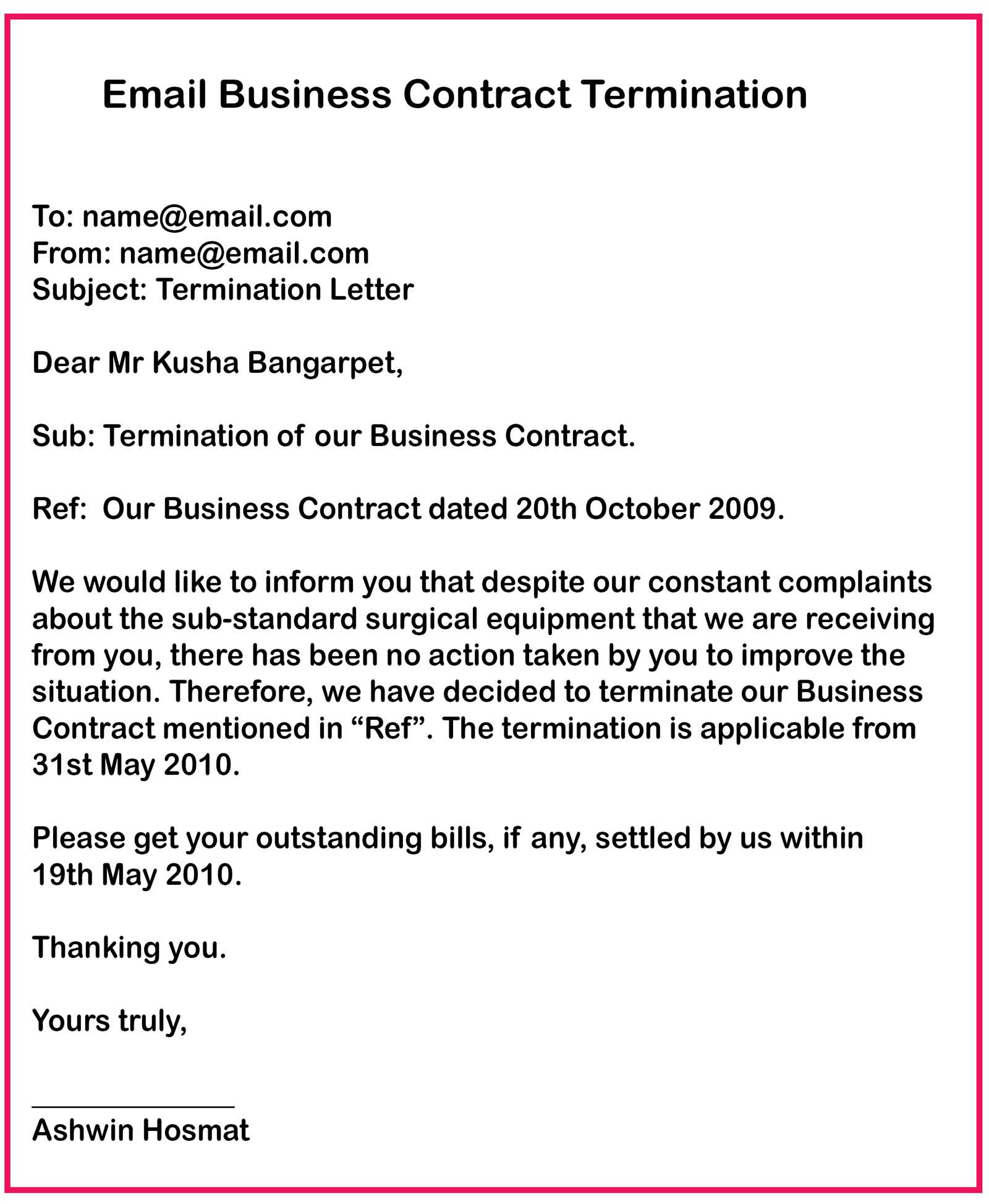
- Outline any outstanding payments, balances, or other obligations to be settled.
- Clarify how final payments will be processed or if refunds are due.
Ensure the tone remains respectful and professional, even if the reason for termination is a result of dissatisfaction. Offer a clear next step or request, such as scheduling a meeting or discussing the next steps for an organized wrap-up.
Review any contracts or agreements before terminating the relationship. Pay special attention to termination clauses, penalties, and any required notices or procedures. Adhering to these terms can prevent potential legal disputes.
Addressing Outstanding Obligations
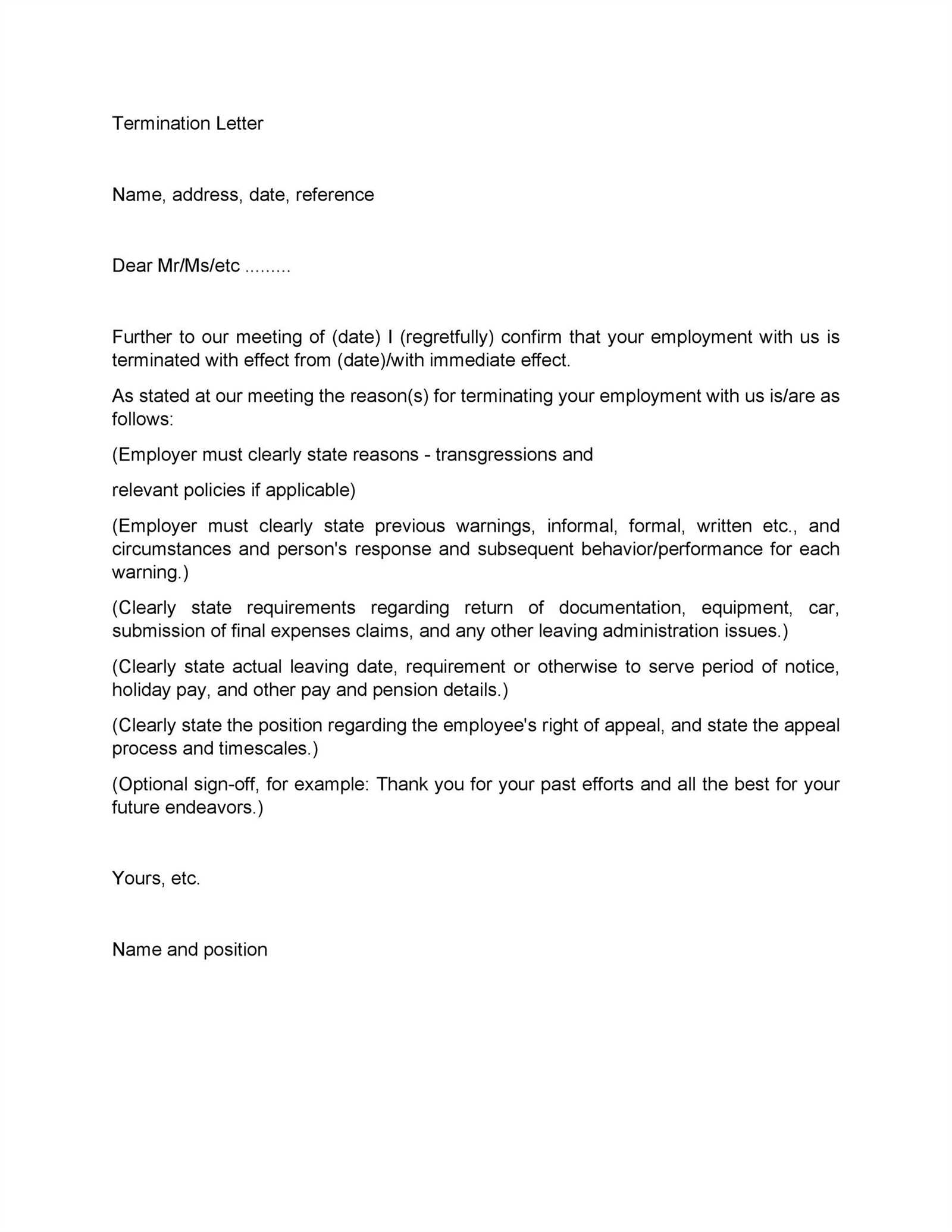
Make sure to settle any pending obligations such as payments, deliveries, or services. Unresolved financial matters may complicate the termination process and lead to claims of breach of contract.
Confidentiality and Non-Compete Clauses
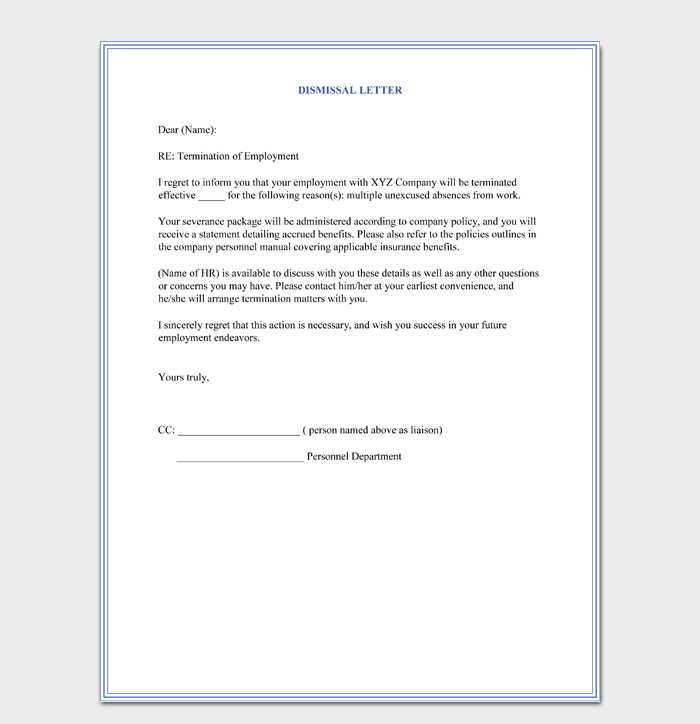
Confirm whether any confidentiality or non-compete clauses apply after the relationship ends. Violating these terms could result in legal action, especially if sensitive information is disclosed or used improperly.
Document all communication related to the termination. Written records provide protection in case of future disagreements, helping to clarify intentions and actions taken by both parties.
Ensure that intellectual property rights are respected and any proprietary materials are returned or appropriately handled according to the agreement.
Clearly state any unresolved issues within the business relationship, focusing on specific facts. Addressing these points directly helps both parties understand the reason behind the termination and avoids confusion. If there are outstanding payments or contracts, mention them in a neutral tone and outline any steps needed for resolution. Acknowledge any commitments that remain, but remain firm in setting a clear timeline for closure.
Provide Details and Deadlines
Be explicit about unresolved matters, such as pending invoices or unfinished projects. Include any relevant reference numbers, dates, or agreements that clarify the situation. Specify deadlines for resolution or actions required from the other party to ensure everything is handled before the relationship ends.
Suggest Future Steps
If appropriate, propose how both sides can finalize matters. For example, suggest a meeting or call to discuss the next steps. Ensure the letter reflects your desire to close the relationship amicably, while making it clear that all terms must be met for a smooth conclusion.
Begin by addressing the recipient. Include their name and title, ensuring it is spelled correctly. Start with a formal greeting such as “Dear [Name/Title].”
1. State the Purpose Clearly
Clearly outline the reason for terminating the business relationship in the first paragraph. Be direct and concise, mentioning the specific agreement or contract, and why the decision is being made.
2. Provide Relevant Details
Include relevant dates or other necessary details regarding the termination, such as the effective date and any pending obligations. This helps the recipient understand the context.
Keep the tone neutral and professional, avoiding emotional language or personal opinions. Ensure that any legal terms or conditions are referenced accurately to avoid misunderstandings.
End the letter with a formal closing, such as “Sincerely” or “Best regards,” followed by your name, title, and company information, if applicable.
Once the termination letter has been sent, take the following actions to ensure a smooth transition and proper closure of the business relationship:
- Confirm receipt of the termination letter. Reach out to the recipient and verify that they received it, whether by email, postal mail, or another method.
- Keep a record of all communications. Document any responses you receive and maintain an organized file for future reference.
- Assess any outstanding obligations. Review the terms of the agreement and ensure both parties fulfill any remaining responsibilities, such as payments or returns.
- Provide guidance on the transition process. If applicable, offer clear instructions or timelines for the transfer of responsibilities or assets to avoid confusion.
- Follow up on any unresolved matters. If the recipient has any questions or requests, address them promptly to avoid delays or disputes.
- Update relevant parties. Inform internal teams or external stakeholders about the termination, ensuring they are aware of any changes that may affect operations.
- Prepare for potential legal matters. If the termination could lead to legal complications, consult with a legal advisor to address potential risks.
Ensure that your termination of business relationship letter is clear and straightforward. This helps both parties understand the decision and prevents any misunderstandings. The first step is to clearly state the purpose of the letter at the beginning. Mention the date the business relationship will officially end.
Addressing Specifics
Detail the reasons for ending the relationship without being overly detailed or accusatory. Keep it brief, focusing on the factual basis for the decision. If necessary, refer to any prior discussions or agreements that led to this point.
Final Steps
Conclude the letter by addressing any outstanding issues, such as final payments or return of property. Be clear about expectations for both parties moving forward. Thank the recipient for their cooperation, and offer any necessary contact information for follow-up.